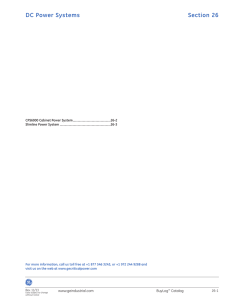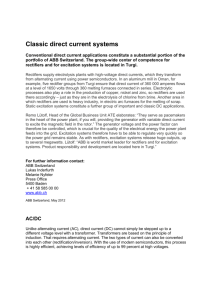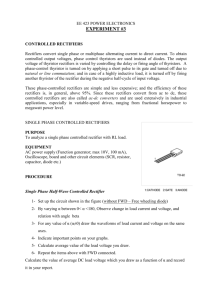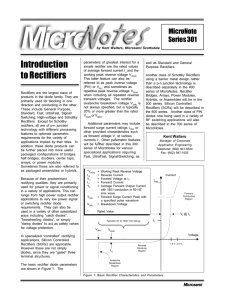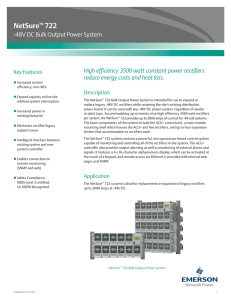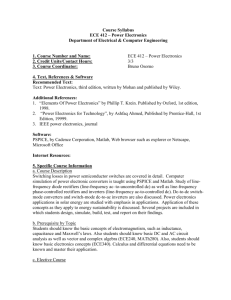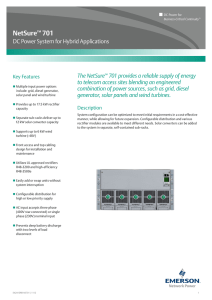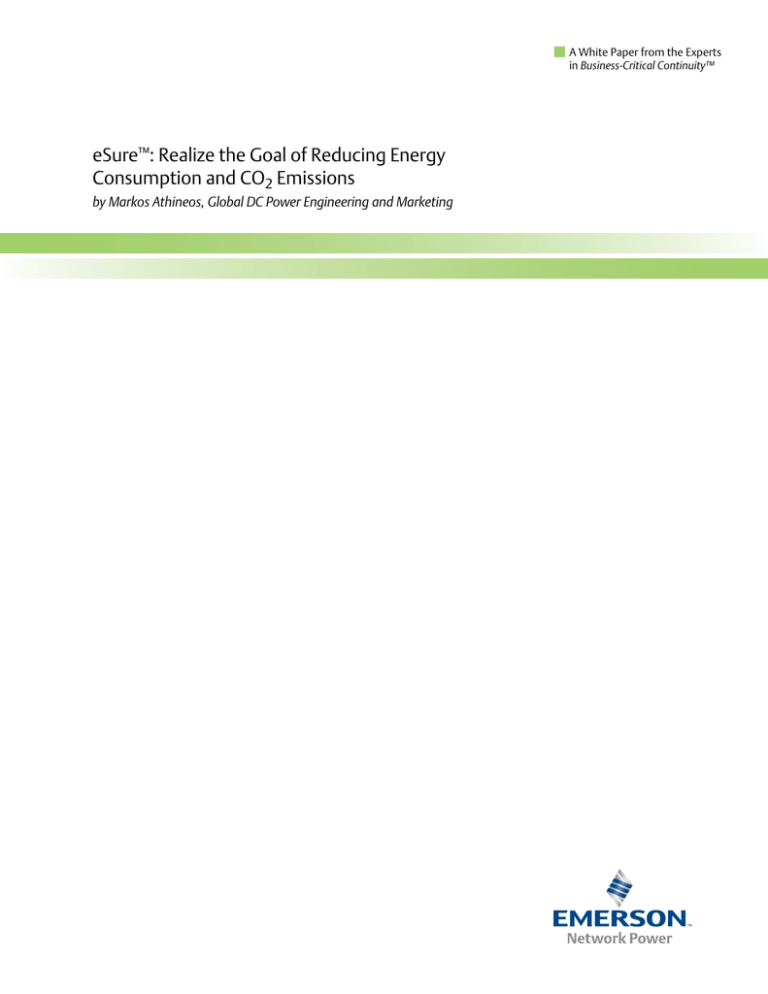
A White Paper from the Experts
in Business-Critical Continuity™
eSure™: Realize the Goal of Reducing Energy
Consumption and CO2 Emissions
by Markos Athineos, Global DC Power Engineering and Marketing
Consumer demand for high-speed and mobile communications
platforms is pushing feverish deployment of broadband and
wireless networks worldwide. Among the challenges this presents
is the accompanying increase in energy consumption—which is a
large portion of operating expenses for telecom providers. In fact,
the Telecommunications Industry Association (TIA) cites vendor
estimates that about 15 percent of telcos’ operational expenditures
are power-related.
The data below [Table 1] shows the energy consumption of 5 major Telecom Providers.
Through extrapolation of this data it is estimated that the telecommunications industry consumes 165TWh (1TWh=1billion KWh) which amounts to 1 percent of the total worldwide
electricity demand. When you step back and look at the bigger picture, it becomes clear that
power consumption has a huge impact on the bottom line for telecom providers around the
world. And that doesn’t even consider the carbon footprint that comes with such massive
energy consumption. The 165TWh produces an estimated 99 million metric tons (1metric
ton=1000Kg) or the equivalent CO2 emissions of 20 million cars [7].
[1][2][3][4][5]
Table1 1:
Operator
Network
Consumption
Table
– Operator
Network
EnergyEnergy
Consumption
Country
Network
Energy
Consumption
[1][2][3][4][5]
% of Country Total
Energy Consumption
USA
Verizon 2006
8.9 TWh
0.24%
Japan
NTT 2001
6.6 TWh
0.7%
Italy
Telecom Italia 2005
2 TWh
1%
2 TWh
0.4%
1.42 TWh
0.6%
France
France Telecom-Orange 2006
Spain
Telefonica 2006
Telecom providers are paying attention. Skyrocketing energy prices, restrictions on carbon
footprints, and an increased emphasis on corporate responsibility (whether genuine or in
response to external pressures) are pushing telcos to take energy consumption and carbon
reduction seriously. These issues, along with the rising cost and relative scarcity of energy,
have led to an increased focus on energy efficiency. In fact, many telecom providers have
begun including it as a requirement in their requests for information and requests for
proposals from vendors. Decision-makers increasingly weigh the cost of powering a piece
of equipment along with traditional features such as reliability, scalability and flexibility.
Those decisions more and more often are leaning toward earlier replacement of older
equipment in favor of more energy-efficient devices.
The bottom line is telcos can save a lot of money by becoming more energy efficient. But
reducing energy consumption is a challenge when consumer demand for telecommunications services continues to grow. This paper will highlight a major opportunity within the
telecom infrastructure that will help telecom providers realize the goal of reducing both
energy consumption and CO2 emissions.
3
Energy consumption of DC power plants in radio base stations and central office equipment
Central offices and radio base stations
(RBS) constitute a large part of the telecommunications infrastructure. The
DC power plant powers both sites, and
accounts for approximately 10 percent of
the total estimated energy consumption
associated with those sites [Figure 1].
While this may seem insignificant
compared to the consumption of the
remaining pieces of the infrastructure,
the U.S. EPA estimates a 10 percent reduction in energy use by telcos could save
the industry more than $200 million
annually and prevent 2 million tons of
CO2 emissions [6].
Achieving typical corporate green initiatives in today’s telecommunications
industry requires a holistic approach that
seizes on every opportunity to conserve
energy and reduce operational expenses.
Until recently, however, little attention has
been given to the methods for improving the energy efficiency of the DC power
system or the benefits to be gained from
those improvements. But under closer
scrutiny, there are several opportunities
for significant improvement.
1. Upgrading low-efficiency, older
generation rectifiers
Efficiency in DC power rectifiers has been
marked by sporadic improvements over
the past 30 years [Table 2]. Bulk rectifiers
(Ferro resonant, controlled Ferro, SCR,
etc.) were the primary source of telecom
power until the late 1980s and ran at typical efficiencies of 80-85 percent (many
Ferros could exhibit much higher efficiency
but only at max load conditions). The
advent of modular high-frequency rectifiers in the late 1980s introduced higher
power density, reliability and more flexibility and scalability for telecom providers.
Figure 1a: Energy Consumption
of Central
Offices
Central
Office Energy Consumption
Switchgear 3%
Lighting 2%
Use of energy optimization results in a 36 percent
reduction in wasted energy, heat and CO2 emissions.
Telco
32%
Cooling
38%
DC
Power
10%
Broadband
12%
ITE 3%
Telcom
Rectifier
Efficiency
Table
2: Telcom
Rectifier Efficiency
TrendTrend
100% Efficiency
97%
95%
Figure 1b: Energy Consumption
of Radio
Base Stations
Radio Base Station Energy Consumption
4
1960
1970
1980
1985
Modular Soft
Switch HF
Radio
Equipment
61.4%
75%
1990
1995
High Efficiency
Rectifiers
DC Power
11.3%
80%
Feeder 1.2%
Modular Hard
Switch HF
Cooling
25%
85%
Bulk Ferro
RF Load 1.2%
90%
2000
2005
2007
2008
2009
As seen in Table 4, by applying an
advanced system controller scheme, we
can ensure the system operates at optimum efficiency in virtually all conditions.
2. Energy vs. load optimization on
newer power plants
While early “hard-switched” modular rectifiers did not offer much of an improvement
in efficiency, the high-frequency platform
presented opportunities for progressive
improvements in power supply efficiency
as improved switching semiconductors
with lower losses were introduced. The
introduction of “soft switch” topologies
in the mid 1990s allowed efficiencies to
reach a peak of 90-92 percent that until
recently has remained relatively fixed. As
we will see later, replacing these older DC
power plants with the newest generation
of ultra-high-efficiency plants can result in
substantial energy savings and is an attractive and justifiable investment.
The majority of today’s modern DC power
systems are capable of achieving a maximum peak efficiency of 90-92 percent.
However, many of these systems are operating at far less than peak efficiency. As
can be seen in Table 3, many “soft switch”
rectifiers must operate at greater than
35 percent of their rated load in order to
achieve optimum efficiency. Operating
below this optimum load (soft switching
topologies require a minimum amount of
“storage energy” before they can achieve
lossless turn on) can result in up to 7
percent lower peak efficiency.
In this energy management control
scheme, the controller continuously
monitors the load current and will shut
down redundant rectifiers to ensure the
operational rectifiers are running at the
optimum load needed to achieve peak
efficiency. The controller also should rotate
activation of the rectifiers so they share
duty cycles equally over time, ensuring
equal wear on all rectifiers. In effect, this
algorithm acts as an efficiency optimization for the DC system. Rapid load changes
are handled without service degradation or
interruption by the presence of the battery
bank and the quick response of the rectifiers. The system will react to major load
changes quickly by bringing idle rectifiers
online in a matter of seconds.
Because systems are configured with
redundant units and often sized based
on peak load, future demand, battery
recharge rates and worst-case assumptions, many sites operate below 35 percent
capacity. The exception is during peak load
hours and battery recharge state, when
they will operate at 100 percent for the
short time it takes to recharge the battery.
Typical
Efficiency
Load
of Resonant
Rectifier
Table
3: Typical
Efficiency vs vs
Load
of Resonant
Rectifier
94.0% Efficiency
92.0%
90.0%
88.0%
Standard Rectifier
Efficiency Curve
86.0%
84.0%
82.0%
80.0%
10%
20%
30%
40%
50%
60%
70%
80%
90%
100%
Load
5
Energy
Efficiency
Curve
Table
4: Energy
Efficiency Curve
Resulting Efficiency Curve
Using Energy Optimization
92% Efficiency
90%
88%
Standard Rectifier
Efficiency Curve
86%
84%
10%
20%
30%
40%
50%
60%
70%
80%
90%
Load
Consider a typical case with 11 3200W
rectifiers sized for total capacity of 54V@
660A or 35.4kW [Figure 2a]. The actual
operational load is only 165A, or 8.9kW. In
this case each rectifier is operating at 15A—
which is only 25 percent of its rated 60A
full load. As we can see from the standard
rectifier efficiency curve [Table 4], at 25
percent load the efficiency of a standard
soft switch rectifier is only around 88 percent. By utilizing a controller with energy
optimization capability, six of the rectifiers
are placed in stand-by mode (note that
even in standby mode, rectifiers continue
to consume a small amount of energy, but
the impact is small and for simplicity we
will not account for this in the example)
while the remaining five pick up the entire
load [Figure 2b]. With energy optimization
applied, we see the five active rectifiers are
operating at 33A, or 55 percent of their
rating. The efficiency at this load point is
near 92 percent [Table 4].
6
In this case the energy optimization
increases the overall system efficiency by
approximately 4 percent. Without getting into details (we will look at energy
calculation details in later case studies)use
of energy optimization results in a 36 percent reduction in wasted energy, heat and
CO2 emissions. Annual energy savings of
approximately 4230 kWh and a reduction
of 2540 Kg CO2 are realized. At $0.10/KW
this saves $423 annually. Of course, the
potential for energy savings increases with
larger systems.
The savings add up quickly when you consider there are millions of these types of
systems installed all over the world. Several
suppliers have energy optimization mode
integrated into their system controllers, so
realizing this benefit may be as simple as
activating the mode. If you have a system
purchased in the last few years, contact your
supplier to learn how to activate this function and realize immediate and real savings.
Figure 2a: No Energy
Optimization
Figure 2b: With Energy
Optimization
3. New ultra high-efficiency rectifiers
Several suppliers recently have announced
the availability of new ultra-high-efficiency
(UHE) rectifiers. One of these boasts peak
efficiency of near 97 percent (be sure to
review a supplier’s efficiency vs. load curve
and ensure the efficiency being claimed
occurs at a wide range of load conditions
and not just at one isolated point). These
UHE rectifiers represent a paradigm increase
over the standard 90-92 percent that has
existed for the last 15 year [Table 5].
In some cases these UHE rectifiers are
100 percent backward compatible with
their lower efficiency predecessors, making upgrade of existing sites very simple.
These UHE rectifiers can reduce energy
and heat loss by up to 80 percent (when
compared with older systems operating at
84 percent efficiency), resulting in significant reduction in annual energy costs and
CO2 emissions.
When considering these rectifiers, be careful to choose
an experienced and proven supplier in order to ensure
uncompromised reliability and to avoid quality issues
that could offset any gains in energy efficiency.
Achieving this efficiency improvement
requires state-of-the-art technology and
innovative and complex new circuitry. Buzz
words such as “bridgeless pfc,” “synchronous rectification,” “soft switch resonance”
and “digital control” are used to describe
the necessary technologies needed to
achieve this high level of efficiency. With
this in mind, when considering these rectifiers, one must be careful to choose an
experienced and proven supplier in order
to ensure uncompromised reliability and
to avoid quality issues that could offset any
gains in energy efficiency. When selecting
a supplier, be sure to review the field performance of the supplier’s legacy products.
Achieving consistent high reliability across
product lines is a strong indicator that a
company has established strong process
integrity. Buying from a supplier with
proven process integrity will ensure that
the new UHE products provide reliability
consistent with previous generations.
Price is another variable of these UHE
rectifiers. Because of the state-of-the-art
innovation and components needed to
achieve these efficiencies, you can expect
to pay a premium over comparable rectifiers demonstrating standard efficiency (SE).
Next we evaluate three case studies and
examine the financial and environmental
benefits associated with each.
Table 5: Standard vs New Ultra High Efficiency Rectifier
eSure™ Rectifier
Efficiency Curve
98% Efficiency
97%
96%
94%
92%
90%
Standard Rectifier
Efficiency Curve
88%
86%
84%
10%
20%
30%
40%
50%
60%
70%
80%
90%
100%
Load
7
Case 1: Central office upgrade –
replacing older DC power systems
with ultra-high-efficiency rectifiers
Many central office sites continue to be
powered by DC power systems with older
technologies, such as Ferro resonant and
hard-switched modular rectifiers. These
power supplies pose increased reliability
concerns due to end-of-life issues and
increased maintenance costs due to limited
availability of rare, low-volume parts. And
if the maintenance and reliability concerns
weren’t bad enough, these systems typically
operate at efficiencies more than 10% lower
than the newest UHE rectifiers [Table 6].
DC plants typically are sized for loads ranging from 1000A (54KW) up to 10000A
(540KW). The high power demand of
central office equipment means significant
savings and payback when upgrading to
new UHE rectifiers. Another advantage of
upgrading is that the higher power density
of today’s modular rectifiers often means
that you can get the same power within a
much smaller footprint.
In this case, let’s assume a central office
site consists of a 3000A (162KW) plant
that contains Ferro resonant rectifiers.
Ultra
High
Bulk
(Ferro,
Table 6: Ultra
Highvs
vs Bulk
(Ferro,
SCR, etc) SCR, etc)
eSure™ Rectifier
Efficiency Curve
98% Efficiency
96%
94%
92%
3.55KW/h
90%
10 SEER
AC
35484btu/h
88%
86%
10.4KW/h
6.2Kg/h
H
e
a
t
C
O
2
Standard Rectifier
Efficiency Curve 160KW SE System
84%
82%
74.4KW
80%
20%
10%
30%
40%
50%
60%
70%
3.55KW/h
Figure 3b
10 SEER
AC
74.4KW
.785KW/h
35484btu/h
7847btu/h
6.2Kg/h
2.3KW/h
1.4Kg/h
H
e
a
t
C
O
2
H
e
a
t
C
O
2
160KW SE System
@40% load
86% eff
8
10 SEER
10 SEER
AC
10.4KW/h
Ferro Bulk System
.785KW/h
64KW
80%
90%
Ferro Bulk System
Load
Figure 3a
@40% load
86% eff
7847btu/h
64KW
66.3KW
160KW SE System
@40% load
96.5% eff
64KW
Ultra High Efficient System
The plant is operating at 40 percent load,
or 1200A (64kW). At 40 percent load, we
can expect the Ferro resonant to operate
at around 86 percent efficiency compared
to near 97 percent for the new UHE rectifier [Table 6]. Assuming the new UHE
system has built-in energy optimization
mode, we can expect the system to run at
or near its peak efficiency. Figures 3a and
3b represent the energy losses associated
with each type of system.
As we can see from these figures, the
hourly energy consumption is reduced
from 10.4KW/h to 2.3KW/h—a reduction
of 78 percent. This translates to annual
energy savings of approximately 70,932
kWh and 42,560 KG of CO2 emissions
(approximately equivalent to the emissions
of eight automobiles) from improvement
in the DC power consumption alone.
Because the lost energy is in the form of
heat, reducing energy loss by 78 percent
directly equates to heat reduction of 78
percent. In this case we have reduced
heat dissipation by 27,640btu. Assuming
Reducing energy loss by
78 percent directly equates to
heat reduction of 78 percent.
a 10 EER unit, the energy consumption
of a 27,640 BTU air conditioner would
be approximately 2.76kW/h. In order to
determine annual energy savings, we must
estimate how many hours the AC runs
within the central office. A simple and conservative estimate is about 12 hours per
day. Under those parameters, the annual
savings associated with the AC are approximately 12,100 kWh and 7,260 KG of CO2.
This results in a combined total annual savings of approx 83,000 kW and 49,800 Kg
of CO2 emissions [Table 7]. At $0.10 per
kWh, annual energy savings amount
to $8,300 [Table 8].
Let’s look at the return on investment
for the rectifiers only. For a 3000A capacity, we must purchase 50 60A (3200W)
UHE rectifiers. If each of these rectifiers
costs $500 the total rectifier investment
is $25,000. The 10-year ROI (assuming 40
percent load, $0.10/Kw) is 24 percent with
rectifier payback occurring at just over
three years.
Reducing maintenance costs and reliability risks, demonstrating good corporate
responsibility, and significant reduction
of operational expenses resulting in a 24
percent annual rate of return all provide
strong justifications for replacing older
systems with new UHE rectifiers.
Table 7: Energy Savings Table for Case Study 1
35.2KW DC Power Plant@40% Load
System
Power Loss
Old rect
10.4KW/h
UHE
2.3KW/h
KW Saving
8.1KW/h
CO2 Saving
Annual KWh
(KW x 24 x 365)
Air Conditioning
Power Loss
Total Annual KWh
Annual KWh
(KW x 12 x 365)
DC Plus Air Conditioning
3.55KW/h
0.785KW/h
70932KWh
2.76KW/h
425600Kg
12100KWh
83,000KWh
7260Kg
49,800Kg CO2
Table 8: Annual Savings Table for Case Study 1
System Load for 160KW Capacity Plant
$/KWh
40%
50%
60%
70%
$0.10
$8300
$10379
$12455
$14530
$0.15
$12455
$15568
$18682
$21796
$0.20
$16600
$20758
$24910
$29061
$0.25
$20758
$25948
$31137
$36327
49800Kg
62275Kg
74730Kg
87185Kg
*reduced CO2 emissions
*0.60KgCO2/KW
9
Case 2: New installation
SE (standard efficiency) vs.
ultra-high-efficiency rectifiers
for the UHE rectifier [Table 5]. Figures 4a
and 4b represent the energy losses associated with each type of system.
When considering new installations, one
must carefully consider not only the initial
cost of equipment but also the impact to
long-term cost of ownership. Both energy
efficiency and the reliability of the product can have significant impact on the
long-term operating expenses associated
with your investment. The application is
in an outdoor enclosure and consists of
11 3200W rectifiers being sized for total
capacity of 54V at 660A or 35.2 kW. The
operator has sized the system so it operates at 40 percent load. As we compare
the SE and the new UHE systems, we will
assume that both solutions include the
integrated energy optimization-capable
controller discussed earlier, therefore both
systems will operate at near peak efficiency. Peak efficiency for an SE rectifier is
92 percent compared to near 97 percent
We see from these figures that the hourly
energy consumption is reduced from
1.22KW/h to 0.51KW/h—a reduction of 58
percent. This translates to annual energy
savings of approximately 6,220 kWh and
3,730 KG of CO2 emissions (approximately
equivalent to the emissions of 1.2 automobiles) from reduction in the DC power
losses alone.
hours the AC unit will operate during the
day. This will vary depending on location,
size of enclosure, and other heat-generating equipment associated with the OSP
application. Assuming properly sized AC
in a moderate climate, we can conservatively estimate the AC runs eight hours per
day. Under these parameters, the annual
savings associated with the AC are approximately 706 kWh and 423 KG of CO2. This
results in a combined total annual savings
of approximately 6,930 kW and 4,150 Kg
of CO2 emissions [Table 9]. At $0.10 per
kWh, annual energy savings amount to
$693 [Table 10].
As discussed in the previous case, reducing
energy loss by 58 percent directly equates
to heat reduction of 58 percent. In this
But based on the savings, is the investment
case we have reduced heat dissipation
.416KW/h
10 SEER
worthwhile?
Let’s assume the 3200W
4162btu/h
by 2,422 BTU. Assuming a 10 EER unit,
AC
SE rectifiers are $380 each and that the
the energy consumption of a 2,422 BTU
1.22KW/h 0.73Kg/h
3200W UHE rectifiers are priced at $500.
air conditioner would be approximately
H
C
The total premium
for the
e
O UHE vs. SE sys0.242KW/h. As with the previous case, in
tem would bea$120x112(total number of
t
order to estimate the total annual energy
savings due to air conditioning, we also
must estimate the average number of
35.2KW SE System
15.30KW
@40% load
92% eff
14.08KW
Standard Efficient System
Figure 4a
.416KW/h
Figure 4b
.174KW/h
10 SEER
AC
4162btu/h
15.30KW
10
10 SEER
AC
1740btu/h
1.22KW/h
0.73Kg/h
0.51KW/h
0.3Kg/h
H
e
a
t
C
O
2
H
e
a
t
C
O
2
35.2KW SE System
14.08KW
@40% load
92% eff
Standard Efficient System
.174KW/h
10 SEER
AC
1740btu/h
0.51KW/h
0.3Kg/h
H
e
a
t
C
O
2
35.2KW SE System
14.59KW
35.2KW SE System
14.08KW
@40% load
96.5% eff
Ultra High Efficient System
The payback on the ultra-high-efficiency premium
is 1.9 years with 10-year ROI of 49 percent.
rectifiers) for a total of $1,320. Using $0.10
per kWh and assuming 40 percent load,
the payback on the UHE premium is 1.9
years with 10-year ROI of 49 percent. Note
that it’s not the number of rectifiers purchased that impacts ROI but the operating
load and energy costs. In other words,
based on a given load per rectifier and
fixed energy costs, the ROI and payback
remains constant regardless of quantity of
rectifiers. If you buy one rectifier, the premium payback and ROI at 40 percent load
is the same payback on 1,000 rectifiers
running at 40 percent load. This is important to consider if you already own a DC
plant and are buying rectifiers to expand
existing empty rectifier slots.
Once again we see that that investing the
additional premium is well worth the payback both in energy savings as well as CO2
emission reduction.
Table 9: Energy Savings Table for Case Study 2
35.2KW DC Power Plant@40% Load
System
SE
Power Loss
1.22KW/h
UHE
0.51KW/h
KW Saving
0.71KW/h
CO2 Saving
Annual KWh
(KW x 24 x 365)
Air Conditioning
Power Loss
Total Annual KWh
Annual KWh
(KW x 8 x 365)
DC Plus Air Conditioning
706KWh
6930KWh
423Kg
4150Kg
0.416KW/h
0.174KW/h
6220KWh
0.242KW/h
3730Kg
Table 10: Annual Savings Table for Case Study 2
System Load for 35.2KW Capacity Plant
$/KWh
40%
50%
60%
70%
$0.1
$693
$870
$1044
$1218
$0.15
$1044
$1305
$1566
$1827
$0.20
$1392
$1740
$2088
$2536
$0.25
$1740
$2175
$2611
$3046
4150Kg
5222Kg
6266Kg
7310Kg
*reduced CO2 emissions
*0.60KgCO2/KW
11
Case 3: Upgrading existing
empty rectifier slots with new
ultra-high-efficiency rectifiers
The previous two cases both involved the
installation of a new DC power plant, but
here we will review the case where the
new UHE rectifiers are designed to be 100
percent backward compatible with existing installations. Telecom providers that
recently purchased standard-efficiency
rectifiers may want to realize the benefits
realize nearly full efficiency benefit of UHE
rectifiers? Would it be worth upgrading?
As previously discussed, real-world systems
must be sized for worst-case peak load
conditions and battery recharge, however
typical steady state system loads run at less
than 50 percent most of the time. A savvy
supplier could take advantage of this fact
to make upgrading to UHE rectifiers more
economical and advantageous for existing
customers. This can be done by developing
an innovative energy management feature
What if there were a way to replace only half or even a third
of the rectifiers in a system and still realize nearly full efficiency
benefit of UHE rectifiers?
of these UHE rectifiers, but would find it
difficult to justify replacing all of their newly
installed rectifiers. However, what if there
were a way to replace only half or even a
third of the rectifiers in a system and still
to ensure that during normal load conditions, the lower-efficiency rectifiers are
placed in standby mode. That ensures the
majority of the system load is provided by
the UHE rectifiers [Figure 5].
In addition, if designed properly, this
energy management feature would continuously monitor the load and quickly bring
the lower efficiency rectifiers on line only
when the system load exceeds the normal
steady state load. One more requirement
for this mode would be to ensure readiness
of standby rectifiers by periodically powering up those rectifiers. With this type of
innovative energy management mode
(let’s call it “ECO” mode going forward),
existing customers can be upgraded easily
and economically to take advantage of the
new ultra-efficient rectifier.
Let’s consider the same system configuration as in Case 2. The provider has many
site installations containing the two-rack,
11-rectifier configuration. Some of the
sites already contain the full allotment
of 11 rectifiers while others have empty
rectifier slots. The provider needs to add
Figure 5
W/h
10 SEER
AC
4162btu/h
1.22KW/h
12
H
0.73
C
With the ECO mode, ROI improves from 49 percent to 93 percent
and the payback improves from 1.9 years to just 1.06.
rectifiers to those systems with empty
slots because of additional subscribers in
the area, and must purchase additional
rectifiers to increase capacity accordingly.
When extra rectifiers are needed to fill
empty slots, a savvy customer can take
advantage of ECO mode by analyzing his
already fully configured installations to
identify what the average steady state
load is during non peak loads. Once this is
determined, he need only buy enough UHE
rectifiers as needed to power the steady
state load of his existing systems. The next
step is to replace the low-efficient rectifiers within his existing systems with UHE
rectifiers, and then utilize the SE rectifiers
to fill the empty slots of those systems
that require increased capacity. By implementing the ECO method for rectifier
expansion, providers can upgrade existing
systems to near ultra-high-efficiency with
a significantly smaller investment than
otherwise would be required for one new
installation containing a complete complement of ultra-high-efficiency rectifiers.
Let’s take a look at how this works.
A customer has four existing installations
of the same system as described in Case 2.
Two of the system racks are populated fully
with 11 rectifiers each, while the other two
contain only six rectifiers and five empty
slots each. It’s now time to fill the 10
empty slots that exist in two of the racks.
Option 1, without ECO mode: Customer
can choose to fill the 10 slots either with
new ultra-high-efficient rectifies or with
standard-efficiency rectifiers. Again assuming the SE rectifier is $380 and the UHE
rectifiers are $500 ($120 premium), with
a 40 percent steady state system load
and $0.10/KW energy costs. We know
from Case 2 that 10-year ROI is 49 percent
with 1.9-year payback on the premium.
Assuming the decision was made to
fill empty slots with UHE rectifiers, the
customer now has upgraded two of his
systems from 92 to 94 percent overall
ECO11:Mode
Efficiency
Mixed
6SESystem
Rectifiers) System
Table
ECO Mode
Efficiency of of
Mixed
(5UHE,(5UHE,
6SE Rectifiers)
Mixed System
with ECO
98% Efficiency
96%
94%
92%
Mixed System
without ECO
90%
88%
86%
84%
10%
20%
30%
40%
50%
60%
70%
80%
90%
100%
Load
13
efficiency (the 94 percent systems contain
a mix of five near 97 percent rectifiers and
six at 92 percent efficiency). Let’s note that
compared to standard efficiency, the incremental investment needed to upgrade
these two systems was $1,200 (10 rectifiers x $120 premium) resulting in total
annual energy savings (40 percent load,
$0.10/KW) of $632.
Option 2, with ECO mode: Now let’s look
at what ECO mode brings to the table.
Since the two existing, fully populated
systems operate at 40 percent load, we
will replace only 5 of the 11 rectifiers
from each of these two systems with UHE
rectifiers and use the lower-efficiency
rectifiers to fill the 10 empty slots of the
two systems that need to be expanded.
By activating ECO mode within the two
systems containing a mixture of UHE and
SE rectifiers, these hybrid systems now will
operate at approximately 96 percent overall efficiency [Table 11]. (Note we will not
use near 97 percent because the offline
energy draw of the standby rectifiers does
impact the efficiency.)
In this case, our incremental investment is
the same as without ECO mode ($1,200)
however our resulting energy savings will
be better in this case as ECO mode works
14
Implementing ECO mode for UHE upgrade results in nearly
double the energy savings than upgrading without ECO mode.
to ensure the majority of load is being
provided by the UHE rectifiers only. As
long as the system load remains less than
the capacity of the UHE rectifiers within
the hybrid systems, we will maintain 96
percent overall efficiency (compared to
94 percent without ECO mode). When
load exceeds capacity of the UHE rectifiers, the offline rectifiers will be turned
on to provide the extra load. As offline
standard efficiency rectifiers are brought
online, the overall efficiency will decrease
incrementally from 96 percent, with worstcase system efficiency of approximately
94 percent when all six offline SE rectifiers
are online. We must account for this in our
energy savings estimates.
If the system were to run at 40 percent
nominal load all the time, the total annual
energy savings as compared to standard
efficiency rectifiers is $1,131. However, it’s
not realistic to assume we can maintain
steady state load 100 percent of the time,
as we must also account for peak load and
battery recharge conditions. Let’s estimate
that 20 percent of the time, load exceeds
the UHE rectifier capacity, in which case
SE rectifiers must be turned on. We will
estimate that in these cases we average 70
percent load and only 94 percent (worst
case) efficiency. So 80 percent of the time
our system runs at 40 percent load and
96 percent efficiency, and 20 percent of
the time we run at 70 percent load and 94
percent efficiency. In this case, our annual
savings total .80x$1,131 – $904 (running
at 40 percent load, 96 percent efficiency,
80 percent of the year) plus $221 (running
at 70 percent load, 94 percent efficiency,
20 percent of year) for total annual savings
of $1,125. Implementing ECO mode for
UHE upgrade results in nearly double the
energy savings than upgrading without
ECO mode. When compared to SE systems
the 10-year ROI improves from 49 percent
to 93 percent and the payback improves
from 1.9 years to just 1.06. With a return
like this, ECO mode makes the decision to
upgrade existing slots with UHE rectifiers
a clear choice. Before deciding on a UHE
system, be sure to determine if the supplier has an ECO-like energy management
feature, as this will substantially reduce the
investments needed to upgrade existing
installations down the road.
Conclusion
Telecom providers are responding to skyrocketing energy prices, restrictions on carbon
footprints, and an increased emphasis on corporate responsibility by increasingly looking
for opportunities to reduce energy consumption and carbon emissions. But with demand
for telecom services on the rise, reductions are difficult. These issues are leading to an
increased focus on energy efficiency. Improving efficiency in the DC power plants that
power the central office and outside plant can have a significant impact on telecom
energy consumption.
As we have discussed in this paper, efficiency gains are available through several avenues:
replacement of older generation rectifiers, implementing energy optimization within
newer standard-efficiency systems, and installation of new ultra-high-efficiency rectifiers.
Although some of these actions require front-end investments, the expected ROI clearly
justifies the initial expense.
By taking this holistic approach to energy efficiency, telecom providers can take major steps
toward achieving many of today’s aggressive industry-wide energy efficiency initiatives.
References
[1] Verizon Corporate Responsibility Report 2006
[2] ETSI Work Program on Energy Savings, Beniamino Gorini: Intelec 2007 Proceedings and Life Cycle assessment
for Information Communicaton Technology, NTT Corporation:
[3] Energy Efficiency - an enabler for the Next Generation Network; F. Cuccietti, Telecom Italia.
Bruxelles, January 30, 2006
[4] France Telecom Energy Consumption, HVDC, Cooling Improvements, Didier Marquet and Marc Aubrée,
France Telecom;
[5] Telefonica Corporate Responsibility Report, 2006.
[6] EPA Administrator Looks to Telecommunications Industry for Increased Energy Efficiency Opportunities,
U.S. EPA, November 2001
[7] “Emission facts” ,EPA article EPA420-F-00-013 April 2000.
To learn more about eSure™ ultra high efficiency from Emerson visit www.DCpowerefficiency.com.
15
Emerson (NYSE: EMR), based in St. Louis, is a global leader in bringing technology and engineering together to provide
innovative solutions to customers through its network power, process management, industrial automation, climate
technologies, and appliance and tools businesses. For more information, visit: Emerson.com.
Emerson Network Power, a business of Emerson (NYSE:EMR), is the global leader in enabling Business-Critical Continuity™
from grid to chip for telecommunication networks, data centers, health care and industrial facilities. Emerson Network
Power provides innovative solutions and expertise in areas including AC and DC power and precision cooling systems,
embedded computing and power, integrated racks and enclosures, power switching and controls, monitoring, and
connectivity. All solutions are supported globally by local Emerson Network Power service technicians. For more
information on Emerson Network Power’s full suite of solutions specifically supporting the communications network
infrastructure, including NetSpan™, NetReach™ and NetXtend™ outside plant enclosures and equipment, NetSure® DC
power systems, and turnkey services, visit: EmersonNetworkPower.com/EnergySystems.
Learn more about Emerson Network Power products and services at: EmersonNetworkPower.com.
This publication is issued to provide outline information only which (unless agreed by Emerson Network Power Energy Systems, North America, Inc. in writing) may not be
used, applied or reproduced for any purpose or form part of any order or contract or be regarded as a representation relating to the products or services concerned. Emerson
Network Power Energy Systems, North America, Inc. reserves the right to alter without notice the specification, design or conditions of supply of any product or service.
Emerson®, Emerson Network Power™, Business-Critical Continuity™, NetSpan™, NetReach™, NetXtend™ and NetSure™ are trademarks of Emerson Electric Co. and/or
one of its subsidiaries.
Emerson Network Power
Energy Systems, North America
4350 Weaver Parkway, Warrenville, IL 60555
Toll Free: 800-800-1280 (USA and Canada)
Telephone: 440-246-6999 Fax: 440-246-4876
Web: EmersonNetworkPower.com/EnergySystems
EnergyNet: Secure.EmersonNetworkPower.com
Emerson Network Power.
The global leader in enabling Business-Critical Continuity™.
AC Power
Connectivity
DC Power
EmersonNetworkPower.com/EnergySystems
Embedded Computing
Embedded Power
Outside Plant
Power Switching & Controls
Racks & Integrated Cabinets
Services
Monitoring
Precision Cooling
Surge Protection
© 2009-2010 Emerson Network Power Energy Systems, North America, Inc. All rights reserved.
Code: PWP-096
February 2010

